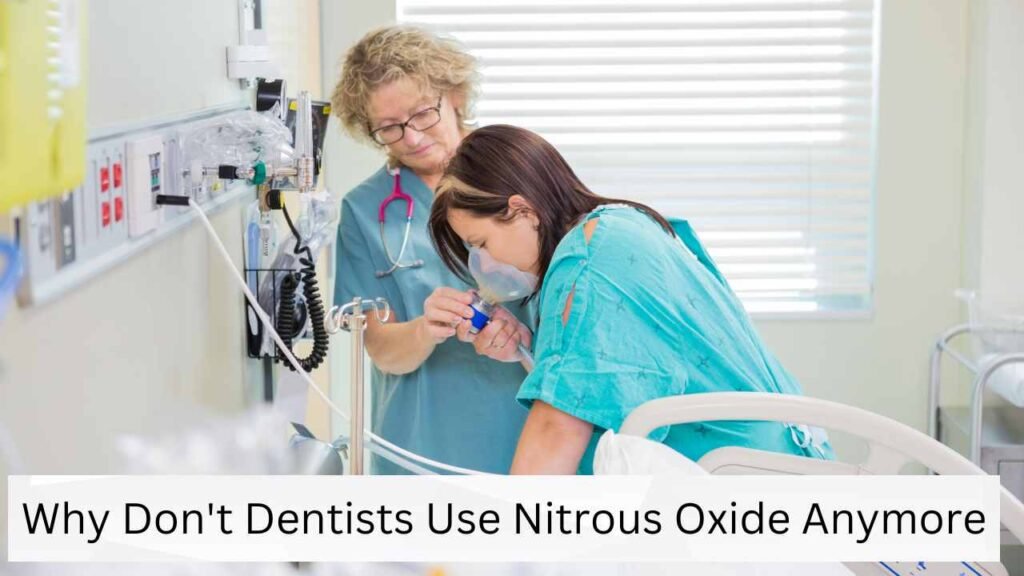Why Don’t Dentists Use Nitrous Oxide Anymore?
Nitrous oxide, commonly known as laughing gas, has long been a staple in dental practices, offering a gentle way to ease patients’ pain and anxiety.
However, recent trends reveal a significant decline in its use. If you’re wondering why this is happening, you’re not alone. Let’s explore the reasons behind this shift and what it means for your dental care.
The Historical Role of Nitrous Oxide in Dentistry

Nitrous oxide has been used in dentistry since the 19th century. Initially celebrated for its effectiveness in pain management and anxiety reduction, it quickly became a popular choice for various dental procedures. Patients appreciated the gas’s rapid onset and minimal recovery time, making dental visits more comfortable.
Factors Behind the Decline of Nitrous Oxide Use
1. Advancements in Local Anesthesia
Modern local anesthetics like lidocaine and bupivacaine have revolutionized pain management in dental procedures. These anesthetics provide effective, targeted numbing with fewer side effects compared to nitrous oxide. For example, lidocaine works quickly to numb the area, making it ideal for procedures like fillings and cleanings without the need for additional sedation.
Imagine a patient scheduled for a routine dental filling. Traditionally, nitrous oxide might have been used to ease anxiety and pain. Today, a local anesthetic like lidocaine can provide precise pain relief without the added step of inhaling gas, simplifying the process and often enhancing the patient’s overall experience.
2. Rise of Oral Sedatives
Oral sedatives such as Valium (diazepam) and Xanax (alprazolam) have become increasingly popular. These medications offer sustained anxiety relief without the need for immediate recovery from sedation. They are easy to administer and can effectively manage anxiety for patients undergoing various dental procedures.
Consider a patient who is particularly nervous about their dental visit. Rather than using nitrous oxide, the dentist might prescribe an oral sedative. The patient takes the medication before their appointment, arriving at the office feeling more relaxed and less anxious, which improves their overall experience.
3. Availability of Other Sedation Options
Intravenous (IV) sedation and conscious sedation offer deeper levels of relaxation. IV sedation, administered directly into the bloodstream, allows for immediate adjustment of sedation levels based on the patient’s needs. Conscious sedation helps patients remain calm and comfortable while staying responsive.
Comparison Table:
| Sedation Method | Advantages | Disadvantages |
|---|---|---|
| Nitrous Oxide | Quick onset, easy to administer, minimal recovery time | Limited for deep sedation, potential long-term side effects |
| Local Anesthesia | Effective pain relief, no sedation required | May not address anxiety, involves injection |
| Oral Sedatives | Easy administration, helps with anxiety | Variable effectiveness, potential drowsiness |
| IV Sedation | Deep, adjustable sedation, good for extensive procedures | Requires monitoring, more expensive |
| Conscious Sedation | Patient remains responsive, effective for various procedures | Not suitable for all patients or procedures |
For complex procedures, such as multiple extractions or root canals, IV sedation provides a higher level of comfort and control compared to nitrous oxide. Patients undergoing these extensive procedures might prefer the deep sedation and adjustment options offered by IV sedation.
4. Safety Concerns and Potential Side Effects
While nitrous oxide is generally safe for short-term use, it has potential long-term effects. Research indicates that prolonged exposure can lead to neurological issues, such as numbness or tingling in extremities. Regulatory bodies like the American Dental Association have acknowledged these risks, leading to increased caution and exploration of safer alternatives.
A study published in the Journal of Dentistry revealed that patients who frequently used nitrous oxide reported symptoms of peripheral neuropathy. This data has prompted dentists to consider other options that pose fewer long-term risks.
5. Cost-Effectiveness
The cost of nitrous oxide can be significant due to the need for specialized equipment and ongoing maintenance. For instance, setting up nitrous oxide equipment can cost between $1,500 and $3,000, with additional costs for gas refills and equipment upkeep. In contrast, oral sedatives and local anesthetics generally have lower initial costs and fewer maintenance needs.
For a dental practice, investing in nitrous oxide equipment represents a considerable expense. Over time, the cost of purchasing gas and maintaining equipment can exceed the expense of using oral sedatives or local anesthetics, which can be more budget-friendly for many practices.
Nitrous Oxide vs. Alternatives
Patient feedback reveals that while nitrous oxide was effective for many, alternatives offer distinct advantages. Oral sedatives and IV sedation are increasingly preferred for their ability to address more severe anxiety or pain during procedures.
The Future of Sedation
Emerging Technologies and Trends
The future of dental sedation is set to include innovative technologies such as AI-driven pain management systems and wearable sedation devices. AI could optimize sedation levels in real-time based on patient feedback, while wearable devices might offer new, non-invasive ways to manage pain and anxiety.
Collaborations in Sedation Techniques
Future advancements may involve collaborations between dentists and anesthesiologists, leading to new, refined sedation techniques that combine the best aspects of various methods. These interdisciplinary efforts could enhance patient care and safety.
Storytelling Expansion: Imagine a future where AI-driven systems adjust sedation levels during a procedure based on real-time data from the patient, or wearable devices provide continuous, comfortable sedation. Such innovations could revolutionize dental care, offering personalized and effective solutions for managing anxiety and pain.
Conclusion
The decline in nitrous oxide usage in dentistry reflects a broader shift towards safer, more cost-effective, and advanced sedation methods. Modern alternatives like local anesthesia, oral sedatives, and IV sedation provide tailored solutions for various patient needs. The decision on which method to use should be made collaboratively between the dentist and patient, ensuring the best possible experience.
For personalized advice on sedation options or to explore the latest advancements in dental care, consult with your dentist. Understanding these changes can help you make informed decisions about your dental procedures.